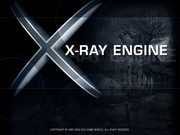X-Ray Engine 1.0
|
X-Ray Engine 1.0 | |
| Разработчик | GSC Game World |
| Платформа | Windows: 2000 (SP4)/ XP (SP2) |
| Разрядность | 32-bit (x86) |
| Игра | S.T.A.L.K.E.R. - Тень Чернобыля |
| Последняя версия | 1.0006 Build 3312 от 27 февраля 2008 года[1] |
| Все версии | 1.0 |
| Исходники | |
| История версий | |
История разработки движка X-Ray берет своё начало в 1998 году, когда двое начинающих программистов GSC Game World: Олесь Шишковцов (Oles) и Александр Максимчук (AlexMX) – объединяются для совместной работы над собственным 3d-движком. К 2000 году, на движке выпускается демо-версия игры "Морской бой". С этого момента начинается многолетняя разработка игры S.T.A.L.K.E.R. и движка X-Ray[2].
| Ссылки на скачивание | |||
|---|---|---|---|
| X-Ray Engine 1.0 |
1.0000-1.0006[3] 1.6.02 Multi-patch[4] 1.6.02 GOG[5] 1.0000-1.0001, 1.0003-1.0006 WorldWide[6] | ||
Разработчики движка[7]
- Олесь Шишковцов – ведущий программист, рендер;
- Александр Максимчук – ведущий программист, редакторы;
- Дмитрий Ясенев – ведущий программист, ИИ/Симуляция;
- Андрей Коломиец – ведущий программист, наполнение;
- Виталий Максимов – программист, сетевая игра;
- Константин Слипченко – программист, физика;
- Сергей Жемейцев – программист, ИИ монстров;
- Сергей Иванцов – программист, оптимизация;
- Юрий Добронравин – программист, наполнение, интерфейс.
Ранние этапы разработки
| Дизайн-документ 2002 года[8][9] |
|---|
|
The engine itself is designed with high scalability in mind to deliver the best possible experience on a wide range of consumer hardware. It is best illustrated by its capability to render high-quality photorealistic images even on low-end video boards with interactive frame rates. When running on high-end hardware the engine automatically utilizes available resources and specific features, such as vertex and pixel shading capabilities, to attain high level of gameplay immersion. Ability to create both indoor and outdoor scenes, realistic physics, scalable network and impressive sound enables us to develop immense game worlds of today and days to come. Powerful tool base allows direct interaction between the engine and popular modelling packages such as 3D Studio MAX, Lightwave3D, Maya, SoftImage, etc. This unique feature allows designers to quickly prototype game levels, effects, etc. Main features:
|
| Презентация 2003 года[10][11] |
|---|
|
X-Ray is a powerful game engine implementing cutting-edge technoligies to make it one of the best 3D engines as of today. The engine's might along with user-friendly tools ensures easy creation of most technologically advanced games with immersing visual and gameplay presentation of newest accelerators generation - NV30,31,34,35. List of main features provided with the X-Ray engine: Common
RenderThe engine features two renderers deigned for DX7,8 and DX 9 generations of video cards. DX7,8 render:
DX 9 Render:DX 9 Render has all the same features as rst renderer, but har following in addition:
Detail objects
Physics
Sound
Network
Tools
AI
|
| Презентация 2004 года[12]
|
Видео
| Демонстрации[13]
|
|---|
| Интервью с разработчиками
|
|---|
Основные особенности
- Lightmapping
- DirectX 9.0c[14]
- Deferred Shading
- Up to 3.000.000 polygons per frame[15]
- Dynamic Soft Ligthing
- Dynamic Soft Shadows
- Multiple Light Sources
- Detail Mapping
- Normal Mapping
- Specular Mapping
- Parallax Mapping
- Dynamic change of Day and Night
- Weather effects
- Wind
- Rain
- Lighting's
- Volumetric Fog - Volumetric Heat Haze
- Retina Blur
- Light Blooming
Источники
- ↑ Информация о версии в лог-файле S.T.A.L.K.E.R. - Тень Чернобыля v1.0006
- ↑ Канал пользователя "Подкаст "Как Делают Игры"" на youtube.com
- ↑ Тема "X-Ray engine [1.0000-1.0006]" на форуме AP Production
- ↑ Тема "X-Ray engine [1.0006, 1.5.10, 1.6.02] - Multi-patch version" на форуме AP Production
- ↑ Тема "X-Ray engine [1.0006, 1.5.10, 1.6.02] - GOG version" на форуме AP Production
- ↑ Тема "X-Ray engine [1.0000,1.0001,1.0003-1.0006] - English edition" на форуме AP Production
- ↑ Титры S.T.A.L.K.E.R. - Тень Чернобыля v1.0006
- ↑ Пост пользователя "Тантибус-кун" на форуме Gameinator
- ↑ Запись в группе "Zone Chronicles" Вконтакте
- ↑ Альбом пользователя "[argus]" на сайте chernobyl-soul.com
- ↑ Снимок страницы stalker-game.com "X-Ray Engine" на сайте web.archive.org, версия от 3 января 2007 года
- ↑ Пост пользователя "Loxotron" на форуме Gameinator
- ↑ Канал пользователя "StalkerVideoArchive" на YouTube.com
- ↑ Пост пользователя "abramcumner" на форуме Gameinator
- ↑ Снимок страницы homelanfed.com "S.T.A.L.K.E.R.: Shadow of Chernobyl Interview" на сайте web.archive.org, версия от 5 августа 2004 года

